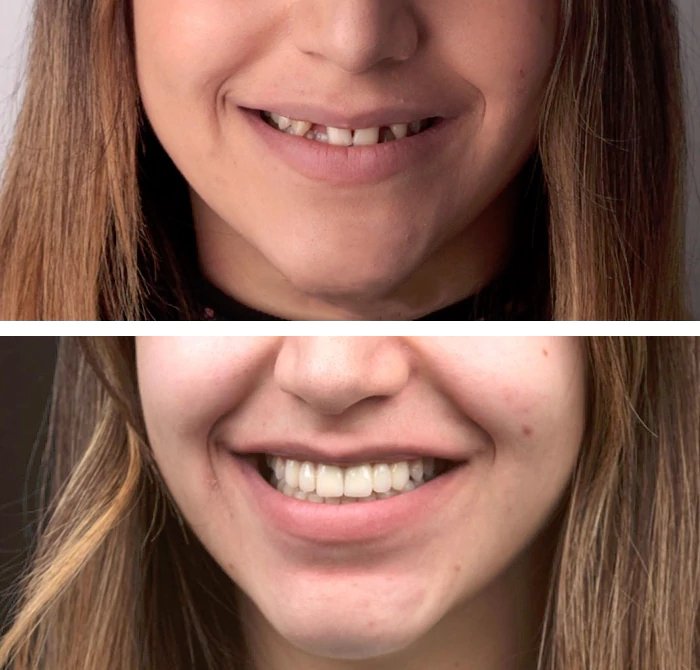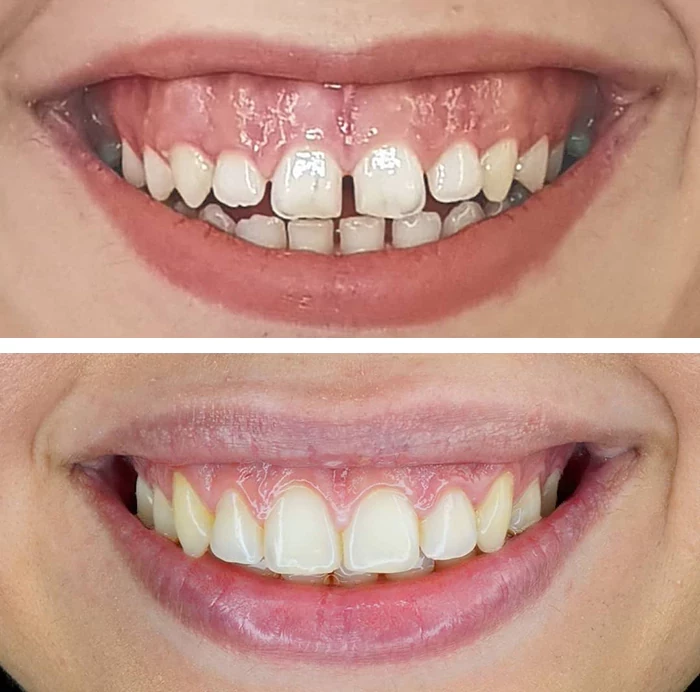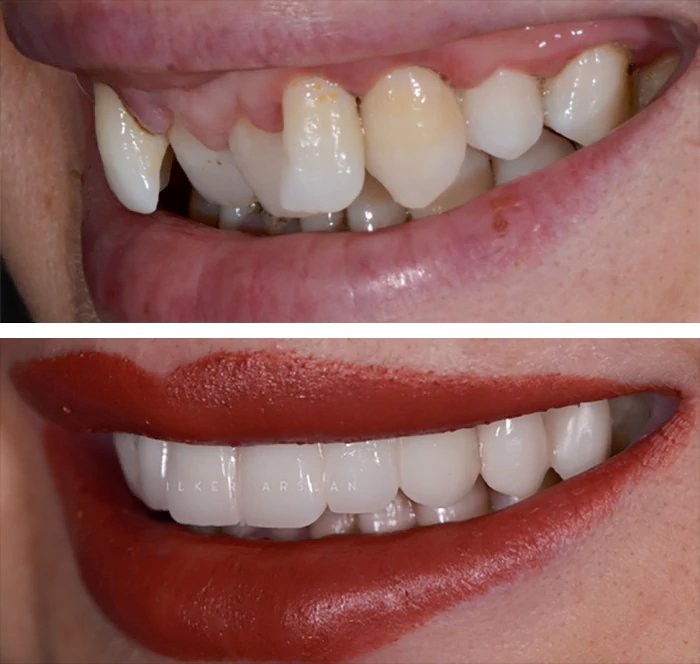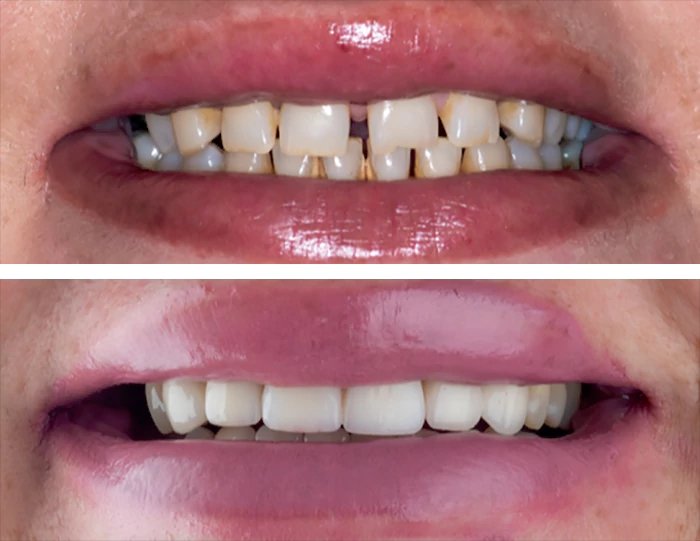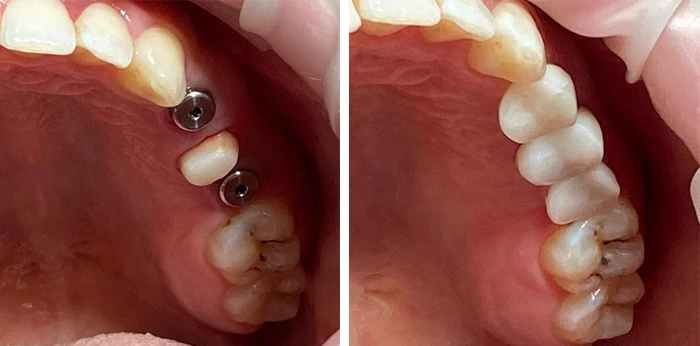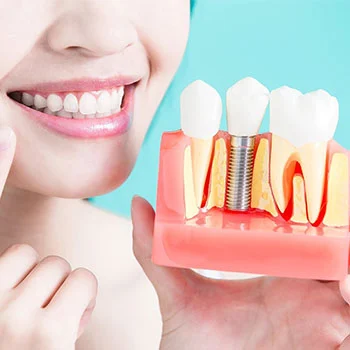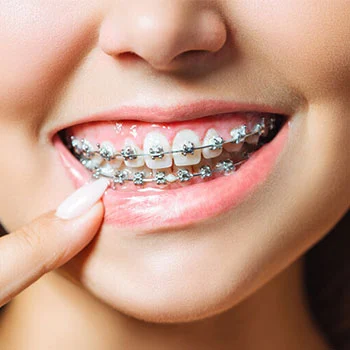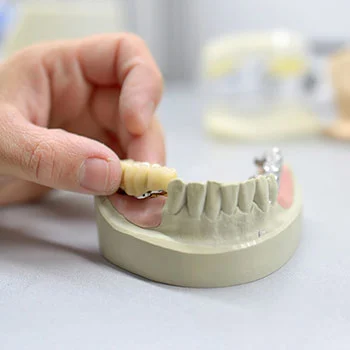What is a dental crown?
A dental crown, also sometimes called a ‘tooth cap’, is a prosthetic cap that is placed over a damaged or decayed tooth to restore its shape, size, strength, and appearance. It fully encases the visible portion of the tooth above the gumline and is custom-made to match the color and shape of the natural teeth. Dental crowns are commonly made from materials like porcelain, ceramic, metal alloys, or a combination of these materials. They are cemented onto the existing tooth or dental implant, providing protection and improving the tooth's functionality and aesthetics.
When is a dental crown needed?
Dental crowns are versatile restorations that can address both functional and aesthetic concerns. A dental crown may be needed in various situations, including:
- Tooth decay: When a tooth has significant decay that cannot be restored with a filling, a crown may be placed to strengthen and protect the remaining tooth structure.
- Fractured or broken tooth: If a tooth is fractured or broken, a dental crown can provide support and prevent further damage.
- Root canal treatment: Following a root canal procedure, where the tooth's pulp is removed, a crown is often placed to protect and strengthen the treated tooth.
- Large fillings: When a tooth has a large filling, a crown may be recommended to provide additional support and prevent further damage to the tooth.
- Tooth discoloration or misshapen teeth: Dental crowns can improve the appearance of teeth that are severely discolored or misshapen, enhancing the overall smile aesthetics.
- Tooth replacement: Dental crowns are commonly used to restore dental implants, providing a natural-looking and functional replacement for missing teeth.
What types of dental crowns are available?
There are several types of dental crowns, each with its own advantages and considerations. Here are some common types of dental crowns:
Porcelain-fused-to-metal (PFM) crowns
These crowns have a metal base with a porcelain coating, providing strength and aesthetics. They offer good durability and natural appearance but may show a dark line at the gumline over time.
All-ceramic or all-porcelain crowns
These crowns are made entirely of ceramic or porcelain material, providing excellent aesthetics as they closely resemble natural teeth. They are a popular choice for front teeth and those with metal allergies. However, they may be less durable than PFM crowns.
Metal crowns
These crowns are made of various metal alloys, such as gold or base metal alloys. They are known for their strength and durability, making them suitable for molars that endure heavy biting forces. However, their metallic appearance may not be desired for visible teeth.
Zirconia crowns
Zirconia crowns are made of a strong and tooth-colored material called zirconia. They offer excellent aesthetics, durability, and biocompatibility. Zirconia crowns are often used for both front and back teeth.
Composite resin crowns
These crowns are made of a tooth-colored composite resin material and are typically used as temporary crowns. They are less durable than other types of crowns but can be a cost-effective option for short-term use.
The choice of dental crown type depends on various factors, including the location of the tooth, aesthetic preferences, budget, and the dentist's recommendation. Your dentist will assess your specific needs and guide you in selecting the most suitable dental crown material for your situation.
Who is a good candidate for a dental crown?
Good candidates for dental crowns are individuals who have:
- Tooth damage: Dental crowns are often recommended for individuals with teeth that are significantly decayed, cracked, fractured, or otherwise damaged beyond what a filling can effectively restore.
- Weakened teeth: Teeth that have undergone root canal treatment or have large fillings and are at risk of further damage may benefit from dental crowns. Crowns provide added strength and protection to the weakened tooth structure.
- Cosmetic concerns: Dental crowns can also address cosmetic issues, such as severely discolored or misshapen teeth, improving the appearance and restoring a more natural-looking smile.
- Tooth restoration after dental procedures: Crowns may be used to restore teeth after procedures like dental implants, bridges, or other restorative treatments, providing functionality and enhancing the overall appearance.
It's essential to consult with a qualified dentist who can evaluate your specific dental condition and determine if dental crowns are the right treatment option for you. They will consider factors like tooth health, oral hygiene, and individual circumstances to provide personalized recommendations.
How is a dental crown procedure performed?
Getting a dental crown is typically an outpatient procedure, which means you can go home the same day. Local anesthesia is commonly used during the procedure to numb the tooth and surrounding tissues. It ensures that you won't experience pain or discomfort during the procedure. The dental crown procedure typically requires two visits to the dentist’s office. Here’s an overview of the steps involved in each visit for getting a tooth crown:
First visit
1- Examination and evaluation: The dentist will examine your teeth and determine if a dental crown is necessary. They may take X-rays to assess the extent of damage or decay.
2- Tooth preparation: If a crown is recommended, the dentist will numb the area with local anesthesia. The tooth receiving the crown will be prepared by removing any decay or damaged portions. The tooth is then reshaped to create space for the crown.
3- Impression: An impression of the prepared tooth and surrounding teeth is taken using dental putty or a digital scanner. This impression serves as a model for the dental laboratory to fabricate the crown.
4- Temporary crown placement: To protect the prepared tooth until the final crown is ready, a temporary crown is placed over it. The temporary crown is usually made of acrylic and is not as durable as the permanent crown.
A waiting period of approximately one to two weeks follows, during which the permanent crown is fabricated in a dental laboratory.
Second visit
5- Removal of temporary crown: The temporary crown is removed, and the tooth is cleaned and prepared for the permanent crown.
6- Checking fit and color: The dentist will check the fit, color, and aesthetics of the permanent crown. They may make adjustments to ensure a proper fit and natural appearance.
7- Numbing the area: Local anesthesia is administered to ensure a pain-free experience during the placement of the permanent crown.
8- Cementing the crown: Once the crown is approved, the dentist will use dental cement to permanently bond the crown onto the prepared tooth. Any excess cement is removed, and the bite is checked to ensure proper alignment.
9- Finalizing the procedure: The dentist will provide instructions on caring for the new crown, including oral hygiene practices and potential temporary sensitivity. They may schedule a follow-up visit to evaluate the crown's fit and make any necessary adjustments.
What to expect before the procedure
Before the dental crown procedure, here's what you can generally expect:
- Consultation: You will have an initial consultation with your dentist to discuss your dental concerns, evaluate the tooth in question, and determine if a dental crown is the appropriate treatment. X-rays may be taken to assess the tooth's condition and determine the extent of any damage.
- Treatment plan: Your dentist will create a treatment plan tailored to your specific needs. They will explain the procedure, discuss the different types of crowns available, and address any questions or concerns you may have. They will also provide information on the cost, expected timeline, and potential alternatives if applicable.
- Preparing for the procedure: If you decide to proceed with the dental crown, your dentist will schedule the first visit. They may advise you to avoid eating or drinking anything for a few hours prior to the appointment, especially if you will receive local anesthesia.
- Anesthesia options: Your dentist will discuss anesthesia options with you. Depending on the case and your preference, they may offer local anesthesia to numb the tooth and surrounding area, ensuring a comfortable experience during the procedure.
- Financial considerations: Before the procedure, it's important to discuss the cost of the dental crown, including any insurance coverage or payment plans available. Your dentist's office can provide details on the financial aspect and help you understand the associated fees.
- Pre-procedure instructions: Your dentist may provide specific instructions to follow before the procedure. This may include avoiding certain medications or supplements that could interfere with the treatment or cause bleeding complications.
It's essential to communicate openly with your dentist, share your medical history, and ask any questions you may have to ensure you are well-prepared and informed before the dental crown procedure.
What’s the recovery and aftercare like?
After the dental crown procedure, here's what you can generally expect in terms of recovery and aftercare:
- Numbness wearing off: If local anesthesia is used, it will gradually wear off after a few hours. During this time, avoid chewing on the numb side of your mouth to prevent accidental injury.
- Sensitivity and discomfort: It is common to experience some sensitivity or discomfort in the treated tooth and surrounding area for a few days after the procedure. Over-the-counter pain relievers can help manage any discomfort, but if the pain persists or worsens, it's important to contact your dentist.
- Eating and drinking: For the first few hours after the procedure, it is advisable to avoid eating until the numbness wears off completely. After that, you can resume your normal eating habits, but it's recommended to start with soft foods and avoid hard or sticky foods that may dislodge or damage the crown.
- Oral hygiene: Maintain good oral hygiene by brushing your teeth gently twice a day and flossing carefully, taking care of the area around the dental crown. Use a toothpaste designed for sensitive teeth if you experience any sensitivity. Regular dental check-ups and cleanings are still important to ensure the health of your teeth and gums, including the crowned tooth.
- Temporary crown care: If you have a temporary crown, it's crucial to be cautious while eating and cleaning your teeth. Avoid sticky or hard foods that could dislodge the temporary crown, and when brushing, use a gentle motion to prevent its accidental removal.
- Follow-up visits: Your dentist will schedule a follow-up visit to check the fit and function of the permanent crown. During this visit, any necessary adjustments can be made to ensure proper alignment and comfort.
It's important to note that everyone's recovery may vary slightly, and your dentist will provide specific aftercare instructions based on your case. If you experience severe pain, the crown becomes loose or dislodged, or if you have any concerns during the recovery period, it's essential to contact your dentist promptly for guidance and assistance.
What are the potential risks?
While dental crown procedures are generally safe, there are some potential risks and complications that can occur, although they are relatively rare. These may include:
- Sensitivity: After the crown placement, some individuals may experience increased sensitivity to hot or cold temperatures. This sensitivity is usually temporary and should subside on its own. Using toothpaste designed for sensitive teeth may help alleviate any discomfort.
- Allergic reactions: In rare cases, individuals may have an allergic reaction to the materials used in the crown, such as metals or ceramics. Inform your dentist about any known allergies or sensitivities to ensure suitable materials are used.
- Discomfort or pain: While discomfort or mild pain is common immediately after the procedure, it should subside within a few days. If the pain persists or worsens, it may indicate an issue with the crown or the underlying tooth, and you should contact your dentist.
- Crown complications: Although uncommon, complications related to the crown itself can occur. These may include the crown becoming loose, cracked, or dislodged. If you notice any problems with the crown, contact your dentist promptly for evaluation and necessary repairs.
- Nerve damage: In rare cases, the dental crown procedure can cause nerve damage, leading to prolonged or permanent numbness, tingling, or altered sensation in the affected tooth, gums, lips, or chin. This risk is generally low, especially when performed by a skilled and experienced dentist.
It's important to discuss any concerns or potential risks with your dentist before the procedure. They can provide you with detailed information about the specific risks related to your case and address any questions or apprehensions you may have. By choosing a qualified dentist and following proper aftercare instructions, you can minimize the potential risks and increase the chances of a successful outcome.
How much does it cost?
The cost of a dental crown can vary depending on several factors, including:
- Geographic location: Dental costs can vary significantly based on the region or country where you receive the treatment. Different areas may have different cost structures and fee schedules.
- Type of crown: The material used for the crown can affect the cost. Common options include porcelain-fused-to-metal crowns, all-ceramic or all-porcelain crowns, zirconia crowns, and metal crowns. Each material has its own cost range, with all-ceramic and zirconia crowns generally being more expensive than metal or porcelain-fused-to-metal crowns.
- Additional procedures: If any additional dental procedures, such as root canal therapy or tooth extraction, are required before the crown placement, they will add to the total cost.
- Dental insurance coverage: If you have dental insurance, it may partially or fully cover the cost of a dental crown, depending on your plan's coverage and limitations. It's advisable to check with your insurance provider to understand the extent of your coverage.
- Dentist's experience and expertise: The fee charged by the dentist can also vary based on their experience, reputation, and location of their practice.
Given these variables, the cost of a dental crown can range anywhere from a few hundred to several thousand dollars per tooth. It's crucial to consult with your dentist, who can provide a more accurate estimate based on your specific needs and circumstances. They can also discuss any available financing options or payment plans to help manage the cost.
What are the alternatives to dental crowns?
There are a few alternatives to dental crowns depending on the specific dental issue you are facing. Here are some common alternatives:
- Dental fillings: For smaller areas of tooth decay or damage, dental fillings may be a suitable alternative to crowns. Fillings involve removing the decayed portion of the tooth and filling it with a composite material, such as resin or porcelain. Fillings are less invasive and require less tooth preparation compared to crowns.
- Inlays or onlays: In cases where the damage or decay is too extensive for a filling but not severe enough to require a full crown, inlays or onlays may be used. These are custom-made restorations that are bonded to the tooth. Inlays sit within the cusps of the tooth, while onlays extend over one or more cusps.
- Dental veneers: Veneers are thin shells made of porcelain or composite resin that are bonded to the front surface of teeth. They are primarily used for cosmetic purposes to improve the appearance of stained, chipped, or misaligned teeth. Veneers are less invasive than crowns and involve minimal tooth preparation.
- Dental bonding: Dental bonding involves applying a tooth-colored resin material to repair chips, cracks, or gaps in the teeth. The resin is shaped and bonded to the tooth, providing a natural-looking restoration. Bonding is a less expensive and less invasive alternative to crowns for minor aesthetic issues.
- Dental implants: In cases where a tooth is severely damaged or missing, dental implants may be considered as an alternative to crowns. Dental implants involve surgically placing an artificial tooth root into the jawbone, onto which a dental crown is attached. Implants provide a long-lasting and natural-looking tooth replacement option.
- Dental bridges: Dental bridges are another alternative to dental crowns, particularly for individuals who have one or more missing teeth. A dental bridge is a fixed dental restoration that spans the gap created by missing teeth and is anchored by dental crowns on the adjacent teeth or dental implants.
- Partial dentures: Partial dentures are removable appliances that replace multiple missing teeth. They consist of artificial teeth attached to a gum-colored base, which is held in place with clasps or attachments.
The most suitable alternative will depend on factors such as the extent of tooth damage or decay, cosmetic concerns, and the recommendation of your dentist. It's important to consult with a dental professional who can evaluate your specific situation and provide personalized recommendations for the most appropriate treatment option.
Dental crown vs bridge vs veneers: what’s the difference?
Dental crowns, dental bridges, and dental veneers are all restorative dental treatments, but they serve different purposes:
Dental crown
- A dental crown is a tooth-shaped cap that is placed over a single damaged or decayed tooth to restore its shape, size, strength, and appearance.
- Crowns are used when a tooth has extensive decay, a large filling, a cracked or weakened structure, or after a root canal treatment.
- The crown completely covers the entire visible portion of the tooth above the gumline, providing protection and reinforcement.
- Crowns can be made from various materials, such as porcelain-fused-to-metal, all-ceramic, zirconia, or metal alloys, depending on the specific needs and aesthetic preferences.
Dental bridge
- A dental bridge is a fixed dental restoration used to replace one or more missing teeth in a row.
- Bridges consist of one or more artificial teeth (pontics) that are held in place by dental crowns on the adjacent healthy teeth, known as abutment teeth.
- The abutment teeth are prepared by removing a small amount of enamel to accommodate the crowns, which act as anchors for the bridge.
- Bridges are a non-removable option for tooth replacement and provide a functional and aesthetic solution for gaps left by missing teeth.
- Like crowns, bridges can be made from different materials, including porcelain-fused-to-metal, all-ceramic, or zirconia, depending on the desired strength and appearance.
Dental veneers
- Dental veneers are thin shells, usually made of porcelain, that are bonded to the front surface of teeth to improve their appearance.
- Veneers are primarily used for cosmetic purposes to enhance the shape, size, color, or alignment of teeth.
- They are commonly used to correct stained, discolored, chipped, worn, or slightly misaligned teeth.
- Veneers are a more conservative alternative to dental crowns, as they require minimal tooth preparation.
- They can provide a natural-looking and durable solution for improving the aesthetics of your smile.
In summary, while both dental crowns and dental bridges involve the placement of crowns, crowns are used to restore individual damaged or decayed teeth, while bridges are used to replace missing teeth by anchoring artificial teeth between dental crowns placed on adjacent healthy teeth. On the other hand, dental veneers are primarily used for cosmetic purposes, improving the appearance of teeth by bonding thin shells to the front surface. The choice between a crown, bridge, and veneer depends on the specific dental condition and the desired outcome, which can be determined through a consultation with your dentist.
FAQs
Are dental crowns permanent?
Dental crowns are not considered permanent, as they may require replacement over time due to wear, damage, or changes in the underlying tooth structure. Regular dental check-ups can help monitor the condition of the crown and ensure its longevity.
How soon after getting a dental crown can I eat normally?
After getting a dental crown, it is generally recommended to wait until the numbness wears off completely before eating. Once the numbness subsides, you can usually resume eating normally, but it's advisable to start with soft foods and avoid hard or sticky foods that may dislodge or damage the crown.
How long do dental crowns last?
The lifespan of a dental crown can vary depending on factors such as oral hygiene, biting forces, and the material used. On average, dental crowns can last between 10 to 15 years, but with proper care and maintenance, they can potentially last even longer. Regular dental check-ups are important to monitor their condition.
Can a fallen crown be reattached?
Yes, in many cases, a fallen dental crown can be reattached. If your crown falls out, it's important to contact your dentist as soon as possible. They will assess the situation and determine if the crown can be reattached. It's crucial to avoid trying to reattach the crown yourself, as improper placement can lead to complications.

